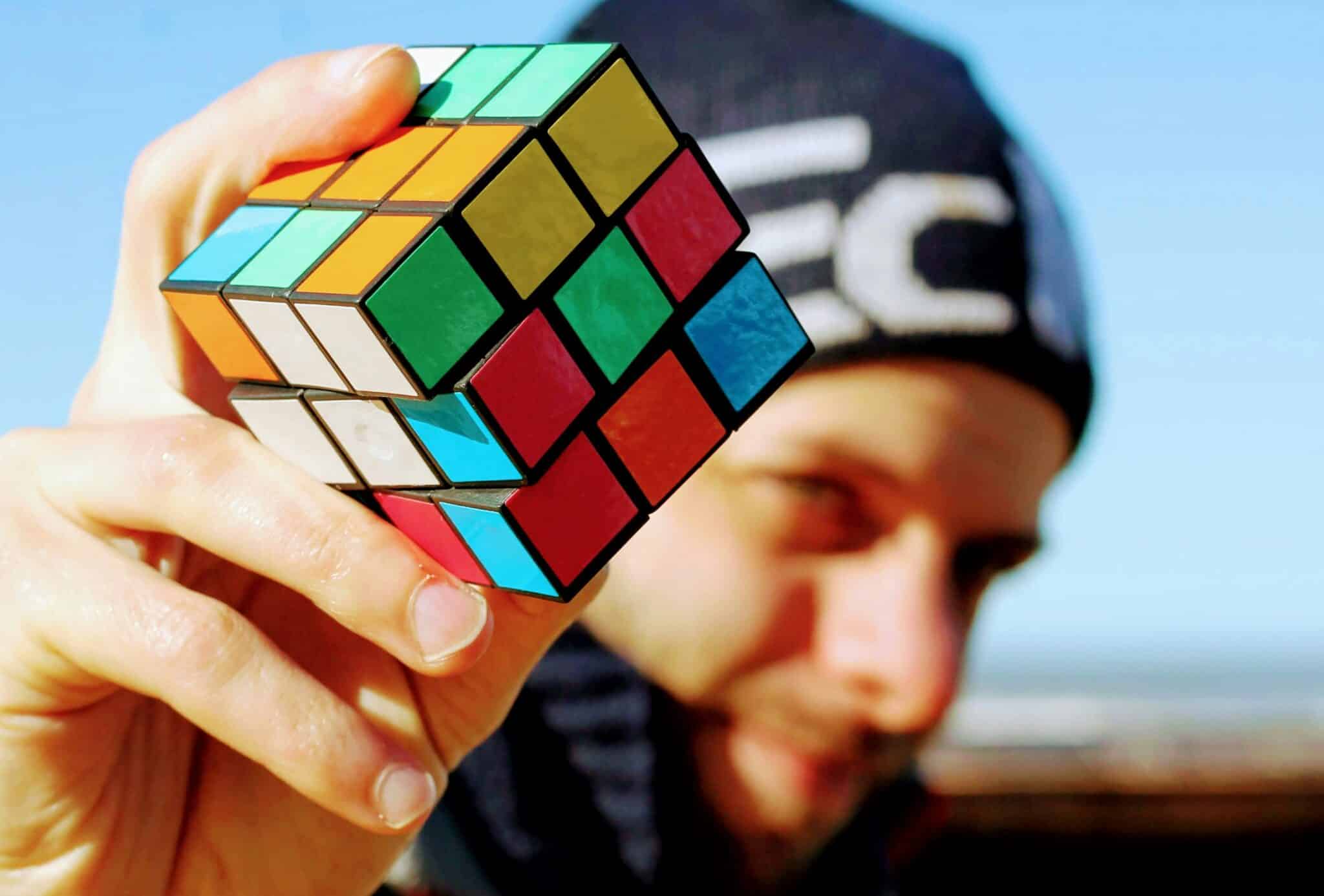An architect, a designer, an inventor, an editor, a professor and more… but for most people, he is known as the man who invented the famous Magic Cube. Ernő Rubik, a remarkably talented and diverse man, turned 80 years old on the 13th of July, 2024. It was 50 years ago that his simple yet brilliant idea unexpectedly turned into a global phenomenon, and he remains a symbol of innovation, and logic today. The name Rubik evokes ideas of creativity all over the world, even if the person behind it is unknown. Where did Ernő Rubik get his inspiration for his famous invention? And who is the man behind the Cube?

Ernő Rubik was born into a family of creators. The son of a flight engineer (Ernő Rubik Sr.) and a poet (Magdolna Szántó), he grew up in the years after World War II. His father remained a great inspiration for all his life: he taught the young Ernő about creating value and working for your goals. Rubik studied architecture and interior design in Budapest, then worked as an architect and designer. University, he recalls, was a strong influence on his life, allowing him to study crafts that needed a great deal of work, persistence, and practice. As Rubik started a position as a professor at the Academy of Applied Arts and Design, he also spent time with his hobby of building geometrical models. This is what soon led him to create a model with a unique story.
The Cube around the Globe
Rubik, as a university professor, needed a demonstration tool for his classes – something practical that his students could use to model three-dimensional movement and talk about engineering basics. The goal was to have the individual pieces of a structure move without the full model falling apart. Rubik took some inspiration from water flowing through pebbles in the Danube, and he came up with a prototype of 27 blocks of wood, held together by rubber bands. The blocks turned along the sides of the cube, and their positions could be swapped, while the cube was still intact. At first, there were no colours and no complex internal pieces, just the bare wooden structure. A simple but creative idea, with lots of potential – the year was 1974.
Soon, Rubik realized that the movements of the cube could be illustrated better if the sides had different colours. So he chose primary colours, with opposite sides only differing in the amount of the yellow colour component each of them had: white with yellow, blue with green, and red with orange. The cube went from a mere demonstration tool to an exciting logical puzzle, and Rubik patented the idea as a “Spatial logical game” under the registration number RU-158 in 1976. The next challenge was producing it. Since Hungary was a planned economy at the time, it was difficult to find someone to manufacture the game, but a company producing chess pieces eventually took on the job and created the first cubes made out of plastic. The “Magic Cube”, as it was called at the time, made its way onto the shelves of shops in 1977, sold by Konsumex, the state trading company.

In 1979, businessman Tibor Laczi took a Cube to the Toy Fair in Nuremberg, Germany in the hopes of spreading its popularity. Tom Kremer, founder of game licensing company Seven Towns, noticed the Cube, and they signed an agreement for Ideal Toys to release the toy worldwide. First, however, it needed a recognizable name: “The Gordian Knot” and “Inca Gold” were popular candidates, but eventually, “Rubik’s Cube” became the winner, bringing fame to the inventor himself. By 1980, the Cube was sold all around the world, with about 100 million official units finding their owners, and probably at least half as many unauthorized ones doing the same. Today, the number of Cubes sold is over 350 million, making the Rubik’s Cube one of the best-selling toys of all time. It received multiple Toy of the Year Awards, and the Museum of Modern Art in New York City included it as a part of its architecture and design exhibit in 1981. (It’s not impossible that Zsazsa Gábor’s US promotion of the Cube helped the process along!) In a nutshell, the Cube became a cultural phenomenon.
The Solution
Of course, one of the most exciting aspects of the Cube is the solution. This is a pretty complex task on paper: after all, the Cube tan take up 43 quadrillion (43×1018) unique positions! If you turned one side every second for 24 hours straight, it would take you 1,371,512,026,715 years to find every position, assuming you don’t repeat any of them. Nevertheless, there are simple algorithms and complex mathematical equations that try to explain how easy or hard the solution is. The lowest number of turns to solve the puzzle (also known as “God’s number”) is mathematically proven to be 20. The current record for the quickest solution is 3.47 seconds for humans, but as fast as 0.38 seconds for robots. The slowest solution belongs to a British fan, who took 26 years between 1983 and 2009 to finally solve it on his own. This is certainly nothing to be ashamed of – it took Ernő Rubik himself a month to first solve his own logical puzzle.
Life after the Cube
The worldwide success of his creation didn’t change Ernő Rubik too much. It is said that he only swapped his old Fiat 500 but didn’t alter his life drastically. He went on to release several other games, including the Rubik’s Snake, Rubik’s Magic, magic domino, the Rubik’s Clock, and Rubik’s 360. (There were also several versions made of the Cube itself, from a 2x2x2 size all the way to 17x17x17.) He edited a journal called …És játék (…And Games) and started Rubik Stúdió, designing games, and furniture. He also became a full-tenure professor and the president of the Hungarian Engineering Academy. In his free time, he says he is an avid reader, enjoys sailing on the Balaton, and collects succulents as his favourite pastime.
Throughout his life, Ernő Rubik has recognized the importance of education. He is involved in several projects to encourage students to start early with studying science, mathematics, and problem-solving. His International Rubik’s Foundation supports young talents in engineering and industrial design. And while he is a living testament to the power of creative thinking; the value of education, hard work, and the creative process is perhaps best highlighted in his own words: “There is only one freedom: when you can do what you love and what you are talented in”.
Vocabulary
| architect | építész |
| editor | szerkesztő |
| remarkably | figyelemreméltón |
| phenomenon | jelenség |
| flight engineer | repülőgép-tervező (mérnök) |
| interior design | belsőépítészet |
| to recall | visszaemlékezni |
| persistence | kitartás |
| demonstration tool | szemléltetőeszköz |
| pebble | kavics |
| to come up with sg | kitalálni valamit |
| intact | sértetlen |
| internal | belső |
| bare | puszta |
| primary colour | alapszín |
| mere | egyszerű |
| to patent sg | szabadalmaztatni valamit |
| planned economy | tervgazdaság |
| to take on the job | elvállalni a feladatot |
| in the hopes of | abban a reményben |
| recognizable | felismerhető |
| Gordian Knot | gordiuszi csomó |
| unauthorized | jogtalan, hamis |
| quadrillion | trillió |
| to be ashamed of sg | szégyellni valamit |
| to alter sg | megváltoztatni valamit |
| journal | folyóirat |
| avid | lelkes, odaszánt |
| succulent | pozsgás növény, kaktuszféle |
| testament to sg | bizonyság valamiről |


